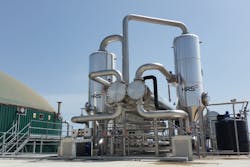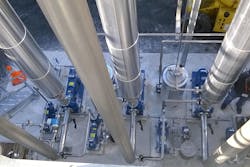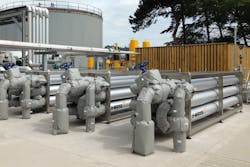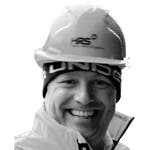The potential of water resources recovery facilities (WRRF) to generate energy via anaerobic digestion (AD) is well understood by those in the industry, as are the economic and environmental benefits of such systems. Less well-known is the extent to which heat exchangers can improve efficiency in wastewater plants.
In many cases, the economic decision about whether to invest in AD will depend on the overall efficiency of the final project. Techniques such as heat recovery using heat exchangers enable a resource that would otherwise go to waste, to be used to preheat feedstock or digesters to improve biogas production efficiency. Equally, this heat can be used for pasteurization and concentration processes, increasing the value of the byproduct extracted from the AD process, known as digestate. Aside from adding heat recovery in new plants, adding or upgrading appropriate technology to existing plants is a way to improve efficiencies.
Upgrading an existing plant presents an ideal opportunity to improve its overall efficiency and to maximize both energy production and overall greenhouse gas savings. One of the easiest ways to improve efficiency is by capturing useful heat, and heat exchangers represent the best way of doing this. In fact, a well-designed heat exchanger system could recover and reuse 40% of the heat produced by a wastewater AD plant.
But not all heat exchangers are equal, and one size does not fit all. Double tube heat exchangers, such as the DTI Series from HRS Heat Exchangers, are often used in the wastewater sector. The DTI Series has an inner tube, which is corrugated to ensure improved heat transfer performance and superior resistance against tube wall fouling, resulting in reduced maintenance periods. In addition, the tube-in-tube design permits the processing of fluids with particles without any tube blockage, making it particularly suited to sewage and AD applications.
HRS Unicus Series evaporators are run at lower pressure in ZLD systems to reduce the boiling point of the liquid being treated.
Using recovered heat
Recovering heat is only the first step. For the process to truly be efficient, it needs to be used for something useful. Heat can be used in the AD process itself — such as to preheat feedstock or digesters to improve gas production efficiency — or anywhere else that heat is required, for example, in evaporation or concentration or for pasteurizing digestate or sludge. Using surplus heat in this way is free and does not require any additional energy. In fact, using a suitable heat exchanger can greatly increase the energy efficiency of operations such as concentration.
Heat can also be used to separate water from digestate by concentration. With a typical 1.5 MW wastewater AD plant producing as much as 44,100 tons of liquid digestate each year — bringing significant economic and logistical challenges associated with its storage and transportation — many operators use their surplus heat to improve their digestate management systems so it does not become a costly bottleneck in plant efficiency.
Concentrated digestate is easier to manage
Using surplus heat to separate water from digestate by concentration can reduce the overall quantity of digestate by as much as 80%, greatly lowering the associated storage and transport costs. A well-designed system, such as an HRS Digestate Concentration System (DCS), will include measures to retain the valuable nutrients in the digestate, while the evaporated water can be condensed and returned to the front end of the AD process, reducing the amount of energy and water used by the plant. After concentration, the treated digestate dry solid content can be as high as 20% (often a four-fold improvement), making it easier and less expensive to transport and handle.
Going beyond clean water to no water
Zero liquid discharge (ZLD) involves transforming liquid waste streams from industrial plants into clean water, which can be reused in the process, thereby removing the solid residues, which often include valuable byproducts that can then be sold or reused. Although every ZLD system is different, many comprise a pretreatment phase, an evaporation phase to remove most of the water, and a further concentration or crystallization phase to produce the final solid residue. Pretreatment often focuses on removing organic elements and any chemicals that could damage equipment. As ZLD has become more widely used, more techniques have been employed at this stage, with varying levels of success. Most common water treatments, such as pH adjustment, flocculation, membrane processing, degasification, oxidation, separation and even aerobic and anaerobic digestion, have all been used as pretreatments for ZLD systems.
Traditionally, vapor compression evaporation has been the main method employed for ZLD processing — with evaporation typically recovering around 95% of wastewater as distillate. Any remaining concentrate is then further treated physically or chemically to produce solid residues and water. Evaporators used in ZLD systems are often run at lower pressures in order to reduce the boiling point of the liquid being treated. The HRS approach to ZLD is composed of three key steps: evaporation/concentration, cooling and crystallization.
The HRS DTI Series of heat exchangers is ideal for pasteurizing sludge in wastewater applications.
Both the evaporation and cooling steps result in a high degree of material fouling on the inside of the equipment, so operators need a heat exchanger that can cope with tough operating parameters. In this case, HRS Unicus Series scraped-surface evaporators are used to maintain thermal efficiency and remove fouling as it occurs in the evaporation process. HRS R Series scraped-surface coolers are also used for cooling the crystal-loaded slurry that is obtained in the crystallization tanks. The result is an efficient process that can work continuously without requiring scheduled downtime.
The level of concentration required for zero liquid discharge systems of this type means the product concentration will have to be above the saturation point so solid crystals will appear in the solution. Solid-liquid mixtures are difficult to handle in a process installation; therefore, HRS Heat Exchangers first completes a research study to evaluate the nature of the saturated product. The evaporator concentrates and removes pure water from the solution, which can be used elsewhere. The coolers and crystallizers produce solid crystals, and the remaining solution returns to the evaporation process. No liquid waste stream remains after the process. This way, any waste management costs are reduced to a minimum.
However operators want to treat their wastewater streams, it is likely that the right choice of heat exchanger can help them do so more efficiently, saving time, money and energy.
Matt Hale is the international sales and marketing director for the HRS Group. He is responsible for overseeing and developing the company’s strategies for business development and marketing. Hale has a background of more than 20 years within process and mechanical engineering and aims to provide effective heat transfer solutions to overcome industry challenges. With a focus on renewable energy, he works closely with the global sales teams to achieve their goals.





